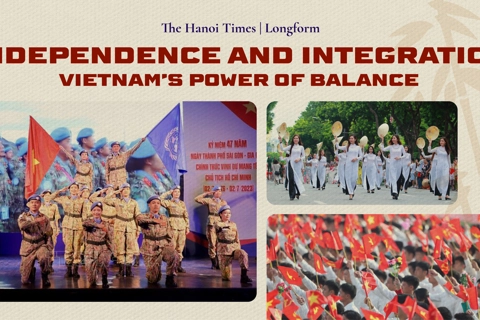Vietnam
Vietnam joins biggest-ever SEACAT exercise led by US Navy
Aug 21, 2019 / 03:21 PM
Among 11 partner nations, Vietnam helps promote shared commitments to maritime partnerships, security and stability in Southeast Asia.
The US Navy and maritime forces from Vietnam and nine Indo-Pacific partner nations have participated in a multilateral exercise that focuses on maritime security operations held on August 19-20.
The exercise – the 18th iteration of Southeast Asia Cooperation and Training (SEACAT) – in Singapore is designed to enhance maritime security skills by highlighting the value of information sharing and multilateral coordination.
Participating nations include Bangladesh, Brunei, Cambodia, Indonesia, Malaysia, the Philippines, Singapore, Sri Lanka, Thailand, the United States, and Vietnam.
SEACAT promotes shared commitments to maritime partnerships, security and stability in Southeast Asia.
“SEACAT is regional maritime security at its best,” said Rear Adm. Joey Tynch, commander, Task Force 73. “This year, more partner nations than ever have come to SEACAT to share their challenges and best practices. There’s no better place to strengthen our abilities to sense, share and respond than working together at sea.”
Throughout the exercise, maritime forces from the Indo-Pacific region will operate together, executing a variety of realistic scenarios designed to reinforce interoperability in areas such as visit, board, search and seizure (VBSS), maritime domain awareness and maritime asset tracking.
VBSS events will focus on countering numerous kinds of maritime threats. Teams from multiple countries board and seize ships under a number of simulated scenarios.
In all, SEACAT includes 14 ships and more than 400 personnel. US Navy units include the staff of Destroyer Squadron 7; P-8 Poseidon aircraft assigned to Task Force 72 and personnel from Task Force 73. Participants from the U.S. Coast Guard include Maritime Security Response Team West (MSRT) and Pacific Tactical Law Enforcement Team (PACTACLET).
The US Coast Guard Maritime Security Response Team (MSRT) will conduct workshops and seminars on visit, board, search and seizure techniques in Manila, Philippines, addressing a wide-range of topics to include human trafficking, drugs and weapons smuggling and illegal fishing.
US Coast Guard Cmdr. David Negron-Alicea, Defense Threat Reduction Agency maritime advisor for US Embassy Manila, and Philippine Coast Guard Capt. Edgardo T. Hernando, commander, coast guard special operation force, led the opening ceremony for VBSS seminars in Manila.
“I challenge everyone to get to know your fellow Navy and Coast Guard participants - to observe with an open mind, share lessons that you’ve learned and best practices for the future,” said Negron-Alicea. “By the end of the workshop, I look forward to seeing teams comprised of operators from each of the different partner nations here today working together and achieving success.”
SEACAT, which began in 2002 under the name “Southeast Asia Cooperation Against Terrorism”, was renamed in 2012 to expand the scope of training among regional navies and coast guards.
The goal of the SEACAT exercise is to bring together regional nations to engage in “real world, real time” training designed to enhance their ability to communicate, coordinate and counter illegal smuggling and piracy.
The exercise emphasizes realistic training scenarios wherein exercise participants will practice identifying, tracking and boarding of vessels participating in the exercise.

US Coast Guard Cmdr. David Negron-Alicea, Defense Threat Reduction Agency maritime advisor for US Embassy Manila, delivers keynote remarks. Photo: US Navy
|
The exercise – the 18th iteration of Southeast Asia Cooperation and Training (SEACAT) – in Singapore is designed to enhance maritime security skills by highlighting the value of information sharing and multilateral coordination.
Participating nations include Bangladesh, Brunei, Cambodia, Indonesia, Malaysia, the Philippines, Singapore, Sri Lanka, Thailand, the United States, and Vietnam.
SEACAT promotes shared commitments to maritime partnerships, security and stability in Southeast Asia.

Senior Chief Gunner's Mate Deonta Wade, assigned to Destroyer Squadron 7, speaks with participants. Photo: US Navy
|
Throughout the exercise, maritime forces from the Indo-Pacific region will operate together, executing a variety of realistic scenarios designed to reinforce interoperability in areas such as visit, board, search and seizure (VBSS), maritime domain awareness and maritime asset tracking.
VBSS events will focus on countering numerous kinds of maritime threats. Teams from multiple countries board and seize ships under a number of simulated scenarios.
In all, SEACAT includes 14 ships and more than 400 personnel. US Navy units include the staff of Destroyer Squadron 7; P-8 Poseidon aircraft assigned to Task Force 72 and personnel from Task Force 73. Participants from the U.S. Coast Guard include Maritime Security Response Team West (MSRT) and Pacific Tactical Law Enforcement Team (PACTACLET).

US Coast Guard Maritime Enforcement Specialist 1st Class Damien Renzi. Photo: US Navy
|
The US Coast Guard Maritime Security Response Team (MSRT) will conduct workshops and seminars on visit, board, search and seizure techniques in Manila, Philippines, addressing a wide-range of topics to include human trafficking, drugs and weapons smuggling and illegal fishing.
US Coast Guard Cmdr. David Negron-Alicea, Defense Threat Reduction Agency maritime advisor for US Embassy Manila, and Philippine Coast Guard Capt. Edgardo T. Hernando, commander, coast guard special operation force, led the opening ceremony for VBSS seminars in Manila.
“I challenge everyone to get to know your fellow Navy and Coast Guard participants - to observe with an open mind, share lessons that you’ve learned and best practices for the future,” said Negron-Alicea. “By the end of the workshop, I look forward to seeing teams comprised of operators from each of the different partner nations here today working together and achieving success.”
SEACAT, which began in 2002 under the name “Southeast Asia Cooperation Against Terrorism”, was renamed in 2012 to expand the scope of training among regional navies and coast guards.
The goal of the SEACAT exercise is to bring together regional nations to engage in “real world, real time” training designed to enhance their ability to communicate, coordinate and counter illegal smuggling and piracy.
The exercise emphasizes realistic training scenarios wherein exercise participants will practice identifying, tracking and boarding of vessels participating in the exercise.








